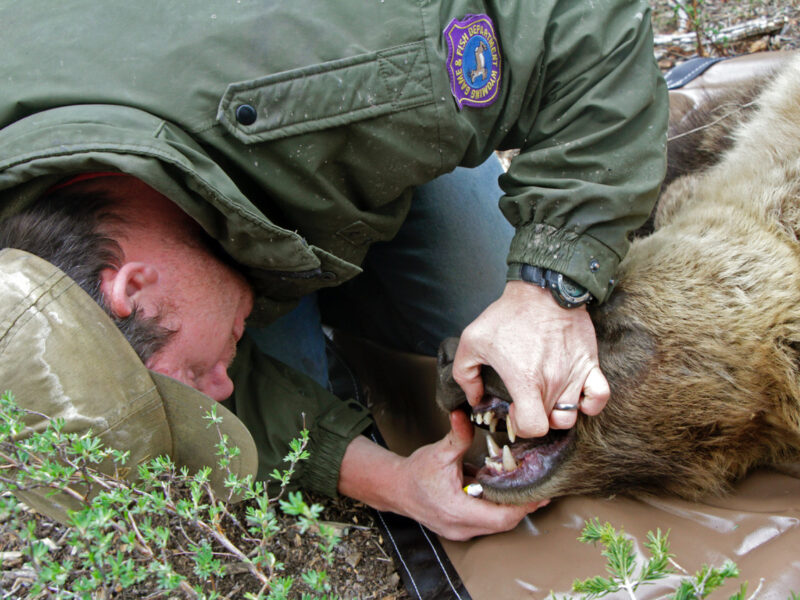Grizzly Relocation: How the Continent’s Largest Omnivores Get New Homes
When bears become risks to themselves or communities, relocation sounds benevolent — but is it?
- Published In: Other News & Features
- Last Updated: Jul 22, 2023

In 2022, the Wyoming Game & Fish Department (WGFD) relocated a total of six trouble-causing grizzlies. So far in 2023, they’ve captured and moved three bruins in a span of just nine days—a trifecta of relocations that may suggest a busy season ahead for wildlife managers. (Courtesy photo from Wyoming Game & Fish)
By Melissa Thomasma
Special to the Wyoming Truth
In 2022, the Wyoming Game & Fish Department (WGFD) relocated a total of six trouble-causing grizzlies. So far in 2023, they’ve captured and moved three bruins in a span of just nine days—a trifecta of relocations that may suggest a busy season ahead for wildlife managers.
“Three grizzlies moved in such rapid succession certainly caught our attention,” Kristin Combs, executive director of Wyoming Wildlife Advocates, told the Wyoming Truth. “We don’t have a crystal ball telling us about the rest of the year, but without question, it’s an important reminder to highlight safe coexistence with bears.”
On July 9, the WGFD relocated a sub-adult female grizzly from the area around Cody into the Blackrock Drainage near Togwotee Pass after she killed cattle on private property. On June 28, two male sub-adult grizzlies were relocated to the Boone Creek area north of Moran in what the WGFD described as “a preemptive move to reduce conflict potential.”
“Relocation is a conservation tool that has been in use for multiple decades and is one of many used in our overall conservation of grizzly bears and mitigation of conflicts,” Dan Thompson, the department’s large carnivore section supervisor, told the Wyoming Truth.
The agency relocated 19 bears in 2021 — nearly double the number of grizzlies relocated in 2020, reflecting that some years are unpredictably busier than others.
Some common ground lies between management agencies and non-governmental advocacy groups around grizzly relocation: stakeholders agree that relocation is preferable to euthanization. But in practice? The consequences of relocating grizzly bears, say some, are more complicated than they seem.

In addition to being protected by the Endangered Species Act, grizzlies are a treasured part of the Western experience for visitors and locals alike. “Grizzly bears once numbered 50,000 and lived from Canada to Mexico,” said Wendy Keefover, of the United States Humane Society.
“Now approximately 2,000 remain.”
Losing them could prove costly, she said, in literal dollars and cents.
Each year, millions of visitors flock to the Greater Yellowstone Ecosystem, hoping to catch a glimpse of a grizzly. And those visitors mean big business: According to the National Park Service, visitors supported 8,736 jobs in the area and had a cumulative benefit to the local economy of $834 million in 2022.
Moving a grizzly is no small task. Advocates contend it can harm bears, negatively affect the population’s health and even damage the progress the species has made toward recovery — in turn harming one of Wyoming’s key economies.
Deciding to relocate a grizzly
When a grizzly demonstrates potential habituation to human-made attractants, relocation isn’t the agency’s knee jerk response, Thompson said.
“Each conflict is unique, and depending on the situation, we may attempt to capture a bear,” he said. Often, Thompson’s team will work with landowners to secure attractants or find other ways to prevent further unwanted interactions — no trapping necessary.
But sometimes that’s not enough.
The process begins when a “target individual” bear is identified as the culprit and is caught in a trap. Thompson’s team takes one of three courses of action: radio collar and release, relocate or euthanize.
“This decision comes after taking into account everything known about that particular conflict and that particular animal, internal deliberations and a final discussion with the U.S. Fish and Wildlife Service,” Thompson said.
Factors influencing an animal’s ultimate relocation site include general suitability, proximity to the federally-designated recovery zone and distance from the temptation that got the bear into trouble.
“The intent is to break the behavior that caused the conflict, take away that conflict potential or buy us enough time to secure the attractant before this or another bear discovers it,” Thompson said.
Bears with a record of threatening human safety aren’t candidates for relocation and are destroyed.
To catch a bruin
A full-grown male grizzly can weigh over 600 pounds and stand over 7 feet tall. Equipped with noteworthy claws and teeth, these omnivores have powerful muscles and sharp senses. How do biologists undertake the gargantuan task of capturing one?
Bear traps, typically constructed of heavy-gauge steel, are called cage culverts — boxy bodies with a door poised to fall shut behind a bear. They’re perched on wheels and easily towed behind a vehicle. After bears are lured in by bait — typically a road-killed elk or deer carcass — and detained, hours can elapse before managers arrive with tranquilizers.

This kind of trapping is far from guaranteed to be harm-free. “Based upon substantial scientific literature, we know that using cage culverts can result in injuries… even death,” Keefover said.
Bears can struggle intensely to escape and can sustain broken limbs and teeth, dislocated joints, lacerations, exposure to the elements and an immeasurable amount of stress or pain.
Combs pointed to a 2019 incident in which the stress of trapping — also known as exertional myopathy — killed a grizzly near Yellowstone.
“The strain and potential injury to a bear is hardly an imagined concern,” she said.
WGFD biologists also would prefer the animals survive a trapping, especially because they can provide insightful data.
“While immobilized, we monitor the temperature, pulse and respiration of the animal, and assess overall condition,” said Thompson. “We collect hair, blood and tissue samples which allow us to evaluate genetics and diet. Each bear is marked with ear tags, a passive implant tag, and a tattoo.” Most bears, he added, are fitted with a radio collar, unless they’re too young.
Though these interactions provide a wealth of data, the biologists’ awe-inspiring experience transcends numbers.
“Every time we capture and handle a grizzly bear it is a special moment for us,” Thompson said. “Being witness to the sheer power and grace of that animal is not something that can be adequately described and is not something most human beings tangibly experience.”
Easing pressures on grizzlies
As more humans encroach on what was once wild land, grizzlies are increasingly likely to cross paths with trouble. “They also face poaching — including by wolf trappers — predator control by ranchers and government agents, mistaken kills by black bear hunters, roadkill and other mortalities,” Keefover said.
She added that these threats are in addition to mounting challenges posed by climate change.
And while relocation is not an immediate death sentence, it can create challenges for a grizzly in unfamiliar territory.
“Grizzlies have established pecking orders,” Combs said. “Introducing a new animal into an area will disrupt the established equilibrium.” This disruption can cause not only injury or death to the relocated animal, but potentially to the other grizzlies who had already called the region home.
It’s much more “rocking the boat” than “happily ever after” in reality.
Ultimately, government agencies and advocacy organizations agree: prevention is ideal for humans and bears alike. If residential communities take protective measures (such as securing garbage, compost, animal feed and bee hives) and ranchers use ranger riders, electric fencing and flagging to keep their livestock safe, Combs said agencies would not have to make the difficult decision about grizzly relocation.
“Coexistence is the only sustainable and ethical path forward,” she said. “Yes, a relocated bear is better than a dead bear. But let’s move upstream and put ourselves in the position to not face that difficult choice at all.”













